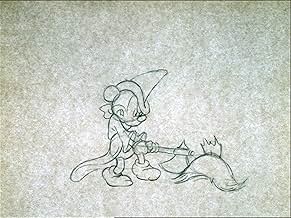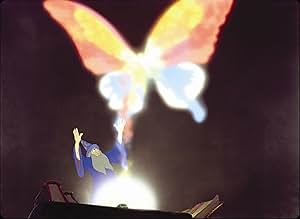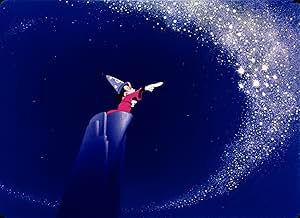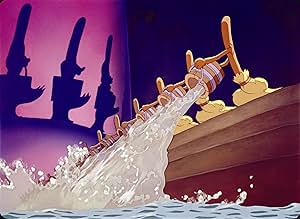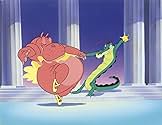Musica da vedere con immagini da ascoltare, nel capolavoro di Walt Disney più famoso: Fantasia! La forza della musica è tradotta in animazioni ora delicate, ora potenti, ora comiche, come ne... Leggi tuttoMusica da vedere con immagini da ascoltare, nel capolavoro di Walt Disney più famoso: Fantasia! La forza della musica è tradotta in animazioni ora delicate, ora potenti, ora comiche, come nell'indimenticabile di Topolino Apprendista Stregone..Musica da vedere con immagini da ascoltare, nel capolavoro di Walt Disney più famoso: Fantasia! La forza della musica è tradotta in animazioni ora delicate, ora potenti, ora comiche, come nell'indimenticabile di Topolino Apprendista Stregone..
- Premi
- 9 vittorie e 1 candidatura in totale
- Narrator: Deems Taylor overdubs (2000 restoration)
- (voce)
- (non citato nei titoli originali)
- Mickey Mouse (segment 'The Sorcerer's Apprentice')
- (voce)
- (non citato nei titoli originali)
- Narrator (1982 version)
- (voce)
- (non citato nei titoli originali)
- Percussionist
- (non citato nei titoli originali)
- Narrator (1985 version)
- (voce)
- (non citato nei titoli originali)
- Soloist (segment 'Ave Maria')
- (voce (canto))
- (non citato nei titoli originali)
- Violinist
- (non citato nei titoli originali)
Recensioni in evidenza
Yesterday I saw "Fantasia" again, now on the Special 60th Anniversary Edition DVD, restored and remastered with audio in THX inclusive with intermission. The program, for those that have eventually never seen or want to recall, is composed by the following:
(1) Toccata and Fugue in D Minor by Johann Sebastian Bach.
(2) Nutcracker Suite by Pyotr Ilyich Tchaikovsky.
(3) The Sorcerer's Apprentice by Paul Dukas.
(4) Rite of Spring by Igor Stravinsky.
(5) Intermission/Meet the Soundtrack.
(6) The Pastoral Symphony by Ludwig van Beethoven.
(7) Dance of the Hours by Amilcare Ponchielli.
(8) Night on Bald Mountain by Modest Mussorgsky.
(9) Ave Maria by Franz Schubert.
My vote is eight.
Title (Brazil): "Fantasia"
1. Bach's Toccata- Brilliant silhouettes of the orchestra, and then masterful abstract images. The orchestra played the piece to a phenomenal standard, and I hate to say this, but I actually prefer the piece orchestrated. It was originally written for organ, you see. The best thing about Stokowski is that you see him conducting without a baton, which is exceedingly clever.
2. Tchaikovsky's Nutcracker- I recommend you see the ballet, because it is a knockout. This is coming from a classical music lover. The animation was superb in this vignette. The most impressive thing though was the fact that the finishes immediately went into the next scene, without it being hackneyed. The waltz, or Dance of the Snow Fairies, was the highlight of this vignette, reminding me so strongly of Christmas.
3. Dukas's Scorceror's Apprentice- The most famous vignette, is the only vignette to feature in the sequel. YenSid(Disney backwards) has a magic hat, which he leaves lying around, and Mickey Mouse picks it up, and encounters various problems. the animation is very good here, and while I'm not a huge fan of the piece, I still found it enjoyable.
4. Stravinsky's Rite of Spring- This is the only reason why the movie isn't a 10. This vignette is far too long It's longer than the Beethoven. It is an interesting subject, dinosaurs, but the ballet wasn't simplified enough. This was boring, and was better left out. It was only here to give some historical context. However, there was beautiful animation and some lovely instrumental solos. Stravinsky hated what the film did to his work, but anyway I don't like Stravinsky much. I had no problem with the animation or the way it was performed, it was just too long.
5. Beethoven's pastoral Symphony- This is a fantastic piece of music. I am a huge fan of Beethoven, and I have all his 9 symphonies on my IPod. My favourites are this, the Choral and the Eroica. I loved the fact that they chose a Greek mythological setting, because it looked gorgeous. My dad who is a conductor wasn't keen on the centaurs, but I loved the winged horses, Bacchus and Zeus (who competes with Chernabog as the most frightening character of the movie). This vignette was so relaxing to watch; think it as like reciting a poem.
6. Ponchielli's Dance of the Hours-This was the funniest vignette of the film, and one of the many gems of Disney. It was a bit unrealistic of course, but it was fun. At first, I was worried that the most famous scene from the opera La Giaconda, would be ruined by the animation. But it wasn't. It was perfect. Even the elephants and hippos, considering their size, danced so elegantly, I was shocked. This vignette is a must-see if you want some comedy.
7. Mussorgsky's Night on Bare Mountain- Now this was my personal favourite, as when I first watched it when I was 10, and I was terrified of Chernabog. The music is also very hard to play, as the mood is very hard to capture, but this is undoubtedly the finest recording of this music. Chernabog was genuinely frightening, and a masterful creation. And the animation, while dark, matched the music, which is enough to give you nightmares, flawlessly. It was very like a Witch's Sabbath, which was what the composer originally intended. Do you know, that for his underrated fantasy movie Legend, Ridley Scott based Tim Curry's Darkness on Chernabog? Children may find it a bit too frightening, and adults may find it inappropriate, as there is a tiny glimpse of nudity. But it was still an effective vignette, and one of my favourite Disney moments actually.
8. Schubert's Ave Maria- This is a beautiful song, and Stokowski did it justice. The harmonies and animation were perfectly captured. how could you say this was boring? The animation couldn't have been happy looking, it would have completely ruined the mood of the song. It was beautifully sung by Juillietta Novis, who was so quiet that you had to turn the volume up, but that was the intention. The thing that impressed me most, was the complete contrast of this from the Mussorgsky, so the key of Ave Maria was so well chosen. (It is sung in many different keys.) In conclusion, the most underrated of the earlier Disney efforts, is well worth watching and a true animated classic! Also I was offended by the review that said that it was the worst movie ever made, and that the people who love this movie need new taste, that is plain insulting to anyone who grew up with this film. 9/10 Bethany Cox.
We learn the modus operandi of "Fantasia", the linking theme, in the second segment - an abridged version of Tchaikovsky's "Nutcracker" suite. (Missing are the overture and the march.) Tchaikovsky's ballet involves anthropomorphising inanimate things, plus the odd tiny animal. So does Disney's "Nutcracker". But Disney has thrown out the particular details. The Chinese Dance is danced by mushrooms (who look, but are not, Chinese); the Arabian Dance by "Arabian" goldfish; the Russian dance by "Russian" thistles and orchids. Sometimes it goes further: "Waltz of the Flowers" shows two entire changes of seasons, with leaves, fairies, seed pods, seeds, snowflakes - everything but flowers. But in ignoring the letter of the instructions Disney is perfectly true to the spirit. Indeed he is more true to the spirit than the original ballet - for, let's face it: stage ballet is a degenerate and over-formalised art, which makes some of the world's most exciting music dull as wallpaper. Disney's amazing images express Tchaikovsky's sense of motion more than earthbound dancers ever could. This, one feels, is the kind of thing ballet music was TRULY designed for. The same goes to a lesser extent for the other two pieces of ballet music on the program.
This basic device - ignoring explicit instructions, but remaining true to the spirit - is carried through into every segment. (Some segments are better than others, but none can be called a failure.) Dukas's "The Sorcerer's Apprentice" has been turned into a Mickey Mouse cartoon - but it's the best Mickey Mouse cartoon ever made; and we realise that the story of the Sorcerer's Apprentice is really the archetype that all of the best Mickey Mouse cartoons had been reaching towards, all along. The Pastoral Symphony adheres to Beethoven's program but moves everything from the woods of Central Europe to a dreamland from classical mythology. (The second movement - the section with the courting centaurs - is a failure. For once the spirit as well as the letter of Beethoven is ignored. Unfortunately some critics cannot see beyond this movement to the superb interpretations that flank it on either side.)
I doubt that so much genuine creative work has gone into a film, before or since - even if you don't count the contributions made by the composers. What's my favourite film? I really don't know. But if you tell me that I must sit in a large dark cinema for two hours; and ask me what I would like to occupy my eyes and ears over those two hours, I would answer, without hesitation, Fantasia.
The eight segments are as follows:
1.) "Tocatta & Fugue in D-minor" composed by Johanne Sebastian Bach. This segment consists of shots of the Philadelphia Orchestra and their conductor Leopold Stokowski with a lot of cool shadow and color effects during the first three minutes, then we see a lot of shapes and random objects that Taylor would suggest to us might pop into our brains when listening to the music.
2.) "The Nutcracker Suite" composed by Tchaikovsky. In this part of the movie, we listen to excerpts of the famous ballet suite, and we see various fairies, flowers, fish and other nature-related creatures.
3.) Everyone's favorite "The Sorcerer's Apprentice" starring Sorcerer Mickey and Yen Sid (the sorcerer whose name is "Disney" spelled backwards). This is also the only segment to be seen again in this film's sequel, "Fantasia/2000" 60 years later, and in it the apprentice brings to life a magical broomstick to try to fill a cauldron with water, and the spell goes wrong so the apprentice gets reprimanded. This is then followed by Mickey greeting conductor Stokowski.
4.) "Rite of Spring" composed by Igor Stravinsky. This segment takes place billions and billions of years ago with the coming of the dinosaurs, where we see the creation of Earth in the beginning of time, and are later introduced to all of the different dinosaurs including the tyrannosaurus rex, which become extinct in the end of the segment.
5.) "Intermission/Meet the Soundtrack". At this point in the film, Deems Taylor introduces this string thingamajigger called the "Soundtrack" that he asks to make a lot of sounds resembling various instrument sounds.
6.) "Pastoral Symphony No. 6" composed by Beethoven. This segment is about a day in the countryside, and in it we see a lot of Greek mythology creatures like unicorns, satyrs, centaurs and centaurettes, cupids, Bacchus, Zeus, Iris, Apollo and Diana.
7.) "Dance of the Hours". This is where we see dancing ostriches, alligators, elephants and hippos. Each part of the piece suggests different hours of the day, and it all ends with a triumphant finale where the dancing hippo takes center stage.
8.) A combination of two pieces that are utterly different in mood and tone. They are "Night on Bald Mountain" in which a bat villain named Chernabog has Satan's evil spirits dance furiously until the coming of the sacred dawn, and then Franz Schubert's "Ave Maria" which is the one and only part of the whole film in which we hear lyrics sung, and then the movie ends.
I simply must say that not only is this film one of my all time favorite animated masterpieces, but it is also an example of a big highlight of the 1940's in cinematic history, all because of the ways it is so unique and special. In addition to this masterpiece, I also think "The Wizard of Oz", "Gone with the Wind", "Citizen Kane" and "Casablanca" are main icons of cinematic successes. I definitely think this should have been the first animated movie to be nominated for the Best Picture Academy Award instead of "Beauty and the Beast".
Lo sapevi?
- QuizDuring production, the animators were given no instructions for coloring. Walt Disney instructed them to use any colors they wanted, which was a first.
- BlooperWhen introducing the "Pastoral" sequence, Deems Taylor mixes Greek and Roman names of deities: Bacchus, Vulcan and Diana are Roman; Zeus, Iris and Morpheus are Greek. Apollo is the only one whose Greek and Roman equivalents have the same name.
- Citazioni
Mickey Mouse: [Pulling on Stokowski's coat] Mr. Stokowski! Mr. Stokowski!
[Mickey whistles to get Stokowski's attention]
Mickey Mouse: My congratulations, sir!
Leopold Stokowski: [shaking hands with Mickey] Congratulations to you, Mickey!
Mickey Mouse: Gee, thanks! Hehe! Well, so long! I'll be seeing ya!
Leopold Stokowski: Goodbye!
- Curiosità sui creditiThere are no closing credits of any kind. Not even the words "THE END" appear on the screen.
- Versioni alternativeBefore the 1990 re-release, the film was shown with no credits other than the title and the RKO logo. Leopold Stokowski received a written credit only on the posters advertising the film. In the film's original roadshow release, not even the title was shown at the beginning of the film - that was saved for the intermission break.
- ConnessioniEdited into Nasce un nuovo mondo (1955)
- Colonne sonoreToccata and Fugue in D Minor, BWV 565
Composed by Johann Sebastian Bach
Orchestrated by Leopold Stokowski (uncredited)
Played by The Philadelphia Orchestra
Conducted by Leopold Stokowski
I più visti
Dettagli
- Data di uscita
- Paese di origine
- Sito ufficiale
- Lingua
- Celebre anche come
- Fantasía
- Luoghi delle riprese
- Aziende produttrici
- Vedi altri crediti dell’azienda su IMDbPro
Botteghino
- Budget
- 2.280.000 USD (previsto)
- Lordo Stati Uniti e Canada
- 76.408.097 USD
- Fine settimana di apertura Stati Uniti e Canada
- 980.798 USD
- 10 feb 1985
- Lordo in tutto il mondo
- 76.414.517 USD
- Tempo di esecuzione
- 2h 4min(124 min)
- Colore
- Mix di suoni
- Proporzioni
- 1.37 : 1





